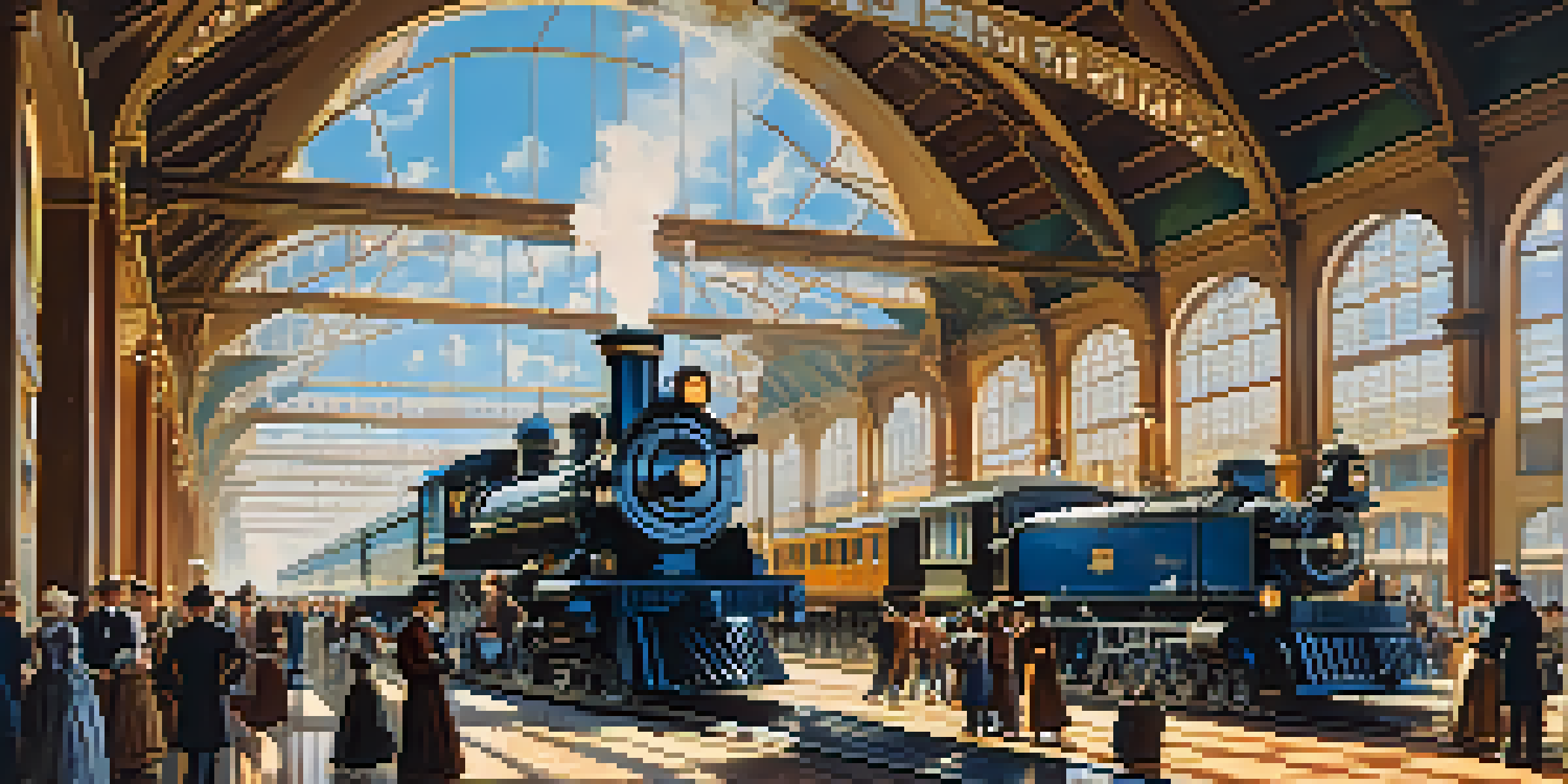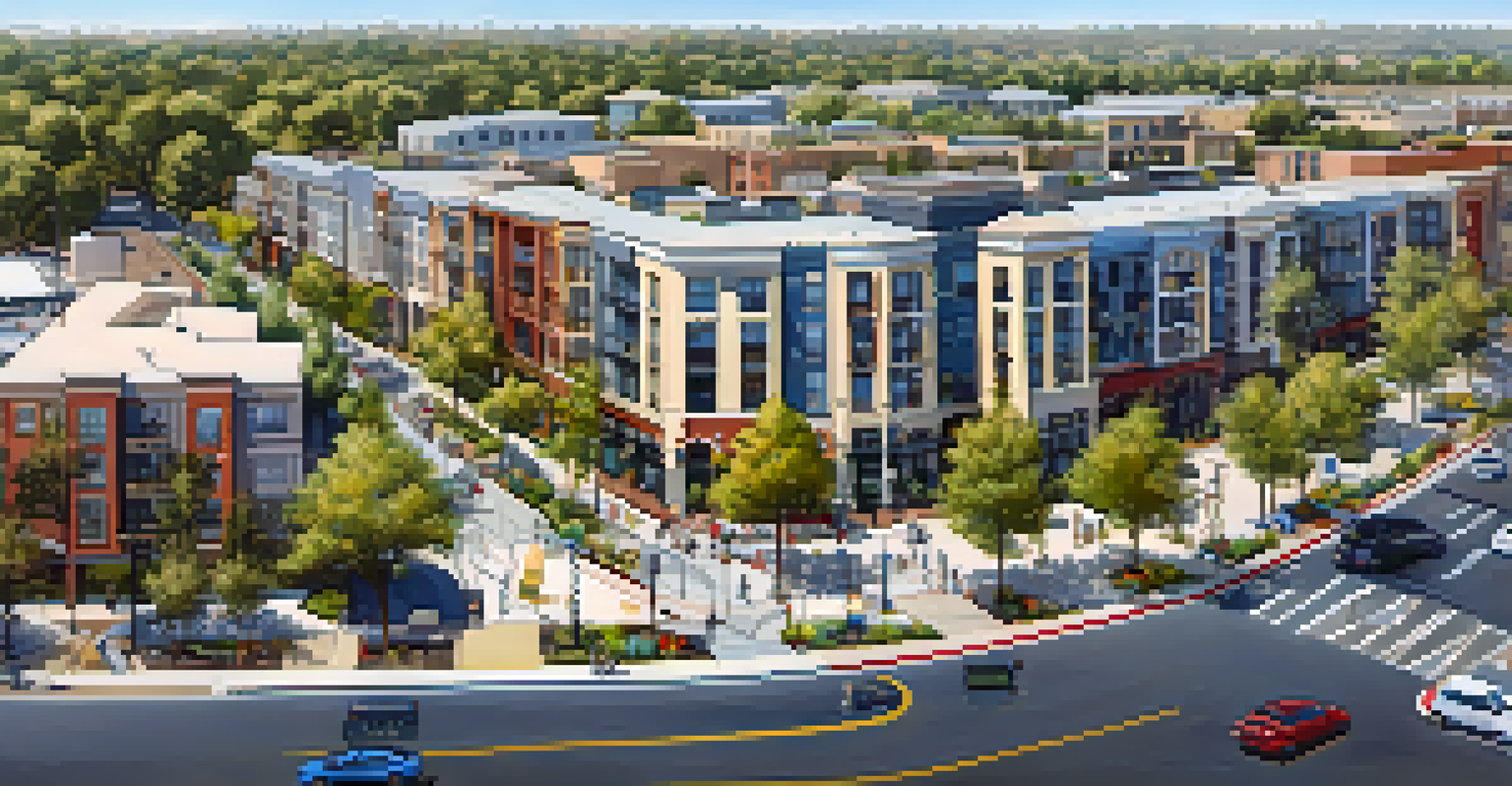The Role of Railroads in Sacramento's Economic Growth

A Historical Overview of Railroads in Sacramento
Railroads have played a pivotal role in Sacramento's history, dating back to the mid-19th century. The arrival of the Central Pacific Railroad in 1863 transformed the city from a modest trading post into a bustling transportation hub. This development not only attracted settlers but also laid the groundwork for Sacramento's growth into California's state capital.
The railroads made a nation, and they made the nation an empire.
As the hub of the western terminus of the transcontinental railroad, Sacramento became a critical link for goods moving east and west. This central position allowed the city to flourish economically, providing jobs and stimulating local businesses. It was during this time that Sacramento established itself as a vital player in the national economy.
The expansion of the railroad network catalyzed the growth of various industries in Sacramento, including agriculture and manufacturing. Farmers were able to transport their produce to wider markets, while manufacturers gained easier access to raw materials. This symbiotic relationship between railroads and local industries paved the way for Sacramento's ongoing economic development.
Economic Boost from Freight Transportation
Freight transportation has been a cornerstone of Sacramento's economy, with railroads being the backbone of this sector. The ability to move large quantities of goods efficiently and cost-effectively has attracted numerous businesses to the area. This has not only provided jobs but also enhanced the competitiveness of local industries.

With major freight lines running through Sacramento, companies can easily ship products across the country, leading to increased trade opportunities. The economic ripple effect is significant, as businesses expand to meet demand and new ventures emerge to capitalize on these logistics advantages. This has fostered a dynamic business environment that continues to evolve.
Railroads Drive Sacramento's Economy
The railroad industry has been a vital economic engine for Sacramento, creating jobs and fostering growth across various sectors.
Moreover, the growth of intermodal transport—where cargo is moved using multiple modes of transportation—has further solidified Sacramento's position as a logistics hub. This seamless integration of rail and trucking services allows for more flexible and efficient supply chains, which is crucial for businesses seeking to thrive in today’s fast-paced market.
Job Creation and Workforce Development
The railroad industry has been a significant source of employment in Sacramento, providing thousands of jobs over the years. From train operators to maintenance workers, the variety of roles created by the railroads has greatly contributed to the local economy. This job creation has not only supported families but also strengthened the community as a whole.
Railroads are the arteries of commerce, and they transport the lifeblood of our economy.
Additionally, the presence of railroads has encouraged workforce development initiatives in the region. Training programs and vocational schools have emerged to equip residents with the necessary skills for railroad-related jobs. This investment in human capital has resulted in a more skilled workforce, better prepared to meet the demands of various sectors.
As the railroad industry continues to evolve with technology, ongoing education and training remain vital. Sacramento's workforce is adapting to new innovations, ensuring that the city remains a leader in transportation and logistics. This adaptability speaks to the resilience of the local economy and its commitment to growth.
Influence on Real Estate and Urban Development
The expansion of the railroad network has significantly influenced real estate and urban development in Sacramento. Areas near rail lines have seen increased property values as businesses and residents seek accessibility and convenience. This has led to a transformation of neighborhoods, with new developments springing up in response to the demand for proximity to rail services.
Moreover, the presence of railroads has encouraged mixed-use developments, where residential, commercial, and recreational spaces coexist. This trend not only promotes sustainable growth but also fosters vibrant communities where people can live, work, and play. The integration of rail services into urban planning is a testament to the enduring impact of the railroads on Sacramento's landscape.
Sustainable Transportation Solutions
Rail transportation offers significant environmental benefits, helping to reduce emissions and alleviate traffic congestion in Sacramento.
As Sacramento continues to grow, the challenge will be balancing development with the preservation of historical sites and green spaces. Smart planning and community engagement are essential to ensure that the railroads contribute positively to the city's future while maintaining its unique character and heritage.
Environmental Considerations of Rail Transportation
Rail transportation is often touted for its environmental benefits compared to other modes of transport. Trains produce significantly lower emissions per ton-mile compared to trucks, making them a more sustainable option for moving goods. This aligns with Sacramento's commitment to reducing its carbon footprint and promoting eco-friendly practices.
Moreover, the efficiency of railroads can help alleviate traffic congestion on highways, leading to less pollution and reduced wear on infrastructure. By encouraging the use of rail for freight, Sacramento can improve air quality and contribute to the overall health of its residents. This shift toward greener transportation solutions is crucial in today’s climate-conscious landscape.
However, the environmental impact of railroads is not without challenges. Issues such as land use, noise pollution, and habitat disruption must be considered in the planning and operation of rail services. By engaging in sustainable practices and community dialogue, Sacramento can navigate these challenges while maximizing the benefits of its rail network.
Railroads and Tourism in Sacramento
Railroads not only serve as a backbone for commerce but also play a vital role in promoting tourism in Sacramento. The city's rich railroad history attracts visitors interested in exploring its historical sites, such as the California State Railroad Museum. This museum showcases the importance of railroads in shaping the region's development and offers an engaging experience for tourists.
Moreover, scenic train routes provide unique opportunities for visitors to experience Northern California's beautiful landscapes. These excursions encourage tourism-related spending, benefiting local businesses such as hotels, restaurants, and shops. This influx of visitors contributes to a vibrant economy and highlights the interconnectedness of railroads and tourism.
Tourism Boosted by Railroad Heritage
Sacramento's rich railroad history not only attracts visitors but also supports local businesses through tourism-related spending.
Events and festivals centered around railroads further enhance Sacramento's appeal as a tourist destination. From train shows to heritage celebrations, these gatherings draw people from all over, showcasing the city’s commitment to preserving its railroad legacy while fostering community spirit and economic growth.
Future Outlook: Railroads in Sacramento
The future of railroads in Sacramento looks promising as the city continues to invest in infrastructure and innovation. Ongoing upgrades to rail lines and stations aim to enhance efficiency and safety, ensuring that rail remains a competitive option for transportation. These improvements will likely attract more businesses and residents, further fueling economic growth.
Furthermore, the integration of technology into rail operations is set to revolutionize the industry. Advances such as real-time tracking and automated systems can streamline logistics, making rail transportation even more appealing. Sacramento's proactive approach to embracing these innovations positions the city as a forward-thinking leader in transportation.

As Sacramento navigates the challenges of urbanization and climate change, the role of railroads will be crucial. By promoting sustainable practices and enhancing connectivity, railroads will continue to be a key driver of economic growth, ensuring that Sacramento remains a vibrant and thriving community well into the future.